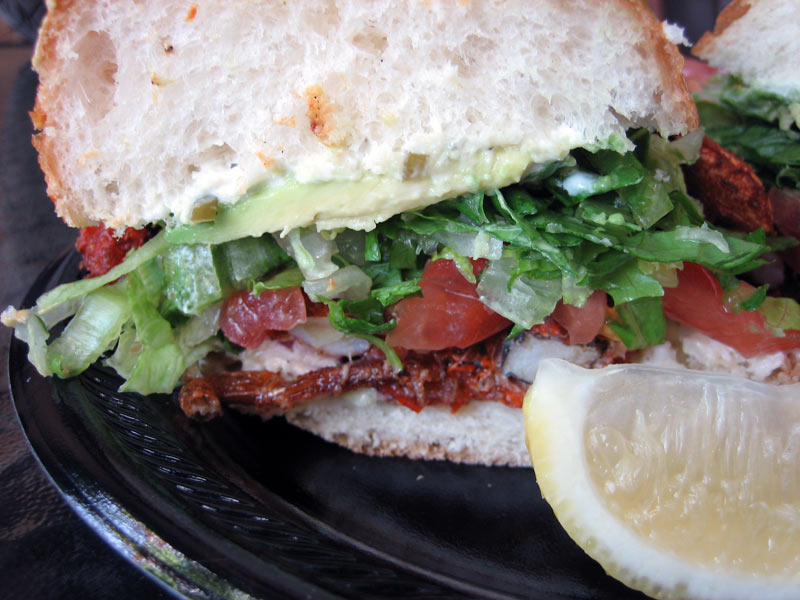...it’s been a long, rainy, busy week.
Today, though, was the first sunny and summer-y day I have been home for. And what better way to celebrate the beginning of a Maryland summer than crabs.
 |
Blue crabs, scientifically known as Callinectes sapidus (meaning savory, beautiful swimmer), is arguably Maryland’s most famous exported product and culinary delicacy that truly lives up to its name. The blue crab is an aggressive, bottom-feeding crustacean that eats almost anything (including their own species); they are also on the menu for many birds and fish. They are an important part of the food chain and environmental habitat of the Chesapeake Bay region. Blue crabs are also integral to Maryland’s economy: more than one-third of the nation’s blue crabs come from the Chesapeake Bay and they have the highest value of any other product of the Bay at approximately $55 million in 2000.
Crabs are so intertwined with Maryland life and culture (especially on the Eastern Shore, where many of the waterman that harvest the crabs live) that they have become somewhat of a pop-culture icon. No Maryland gift-shop or tourist advertisement can be found without at least one image of a blue crab. When tourists come to the city, they are invariably told to seek out crabs, whether steamed, made into crab cakes or fried as a soft-crab. Fried soft-crab sandwiches are perhaps the rarest of these delicacies, primarily because Spring is the peak season for crabs and because they are what I will say the most adventurous way to eat a blue crab.
As crustaceans, blue crabs molt (or shed their old shells) in favor of new and bigger ones as they grow; blue crabs molt, on average, 18-23 times during a three-year life span. Blue crabs have three stages in their molting cycle, colloquially known as peeler, busting and soft-shell. In the peeler stage, the new shell forms underneath of the old. Busting is when a crab starts to “slough out” of their smaller, older shell and crawl out of it leaving them in the soft-shell stage where they wait until their shell becomes completely solid once again in a matter of hours. This process most often happens in the spring-time when the water temperature rises enough so the crab population starts to increase in time for the peak-season of summer. Although it is not a proven fact, this process seems to coincide with a full-moon.
 Chesapeake blue crabs are not the only molting crab that is able to be eaten, however they are the largest and the meatiest, arguably making them the most appealing. Legend has it that soft-crabs were first popularized as food by watermen in Crisfield, Maryland which is located on the lower Eastern Shore of the Chesapeake Bay. Archaeological and historic records show, though, that there was a market for soft-shell crabs in Maryland as early as the mid-nineteenth century.
Chesapeake blue crabs are not the only molting crab that is able to be eaten, however they are the largest and the meatiest, arguably making them the most appealing. Legend has it that soft-crabs were first popularized as food by watermen in Crisfield, Maryland which is located on the lower Eastern Shore of the Chesapeake Bay. Archaeological and historic records show, though, that there was a market for soft-shell crabs in Maryland as early as the mid-nineteenth century.In Maryland, it is traditional to eat a soft-crab fried and between two slices of white bread with tomatoes and mayonnaise. No one really can say how or why this came to be, but I have a hypothesis based on the social and cultural tendencies of the area. Watermen are a simple kind of rural folk, and a blue-collar profession. The best way to prepare a soft-crab is to fry it, to make sure the crab is cooked thoroughly and soft enough to bite through. My guess is that once a soft-crab was caught, it was quickly fried and served in the simplest and most convenient way: in a sandwich. The watermen’s version of the construction man’s bologna sandwich, per se. My particular sandwich comes from the same origins of the watermen’s sandwich.
My family owns a house on the shores of the beautiful Wye River located in Stevensville, Maryland; a small, rural town just outside of Kent Island. Every morning in the summer, one will inevitably see watermen dipping crabs off the sides of their boats. My favorite summer activity happens to be tanning on the pier with my own crab traps set, trying to catch a bushel of my own. Soft-crabs are almost like a prize when caught: whoever catches it has it fried and gets to eat it, the envy of all at the dinner table. My dad happened to be down the shore today, cutting grass and making sure the house is ready for a series of graduation parties that will be occurring soon. This morning, he spotted a few watermen pulling up crab traps. "Too early," he thought. "But if they're out there, there must be something." Out of curiosity, he pulled out some crab pots, baited them and threw them in the water. At the end of the day, lo and behold, there were about a dozen crabs in the pot, two soft crabs and ten hard crabs. Before I left for work, he fried one up for me according to his own recipe and I can honestly say I was a happy girl behind the counter this evening.
No one can say they know the true origin of this particular Maryland delicacy, but one thing is certain: this fried food of lowly origins is one high-class sandwich.
References:
http://www.marylandseafood.org/facts_and_nutrition/featured_species/crabs/soft_crabs.php
Recipes:
Fried Soft-Crab Sandwich a la Mr. Cromer-
- Soft crabs, cleaned
- Bowl full of flour, old bay, black pepper
- Canola oil
è Dredge moist crabs through flour-mixture until heavily coated. Carefully place the crab into hot canola oil in frying pan. Cook until golden brown on both sides, up to 5-6 minutes. Dry on a paper towel, place between two slices of white bread with a slice of beefsteak tomato and mayonnaise to taste.



wooo crabs
ReplyDeleteHi, I Like Your Post…….
ReplyDeleteOn the last day of the month of Ramadan, Jumtat-ul-Vida is socialized by the Muslim community. Ramzan usually comes in the ninth month according to the Islamic calendar.